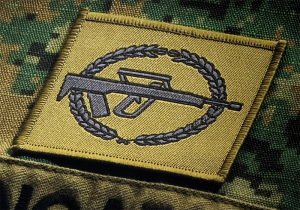BEHIND THE BADGE: FIT TO FIGHT
PHOTO // Chua Soon Lye
In the first of a new series, PIONEER takes a look at some of the Singapore Armed Forces' (SAF's) skills and proficiency badges.
Combat Skills Badge (CSB)
Who is eligible: Open to all combat-fit (PES A or B) servicemen. Personnel must have obtained at least a Silver award in their Individual Physical Proficiency Test and completed a 24km route march in full battle order three months before their CSB test.
The CSB course is part of the syllabus for Infantry, Guards and Commandos vocationalists, as well as Infantry Officer and Specialist cadets, but is also open to other servicemen of non-infantry vocations.
What it takes: The CSB is a rigorous test of participants' infantry skills as well as their physical and combat fitness.
The tests include terrain navigation, first aid and the use of signal sets, claymore mines and infantry weapons such as the Singapore Assault Rifle (SAR) 21, M203 grenade launcher and Section Assault Weapon (SAW).
The test culminates in the gruelling March of Infantry Pride (a 32km trek with rifle, full pack, full ammunition loads and life jacket), which incorporates the crossing of water obstacles and range shooting. Personnel must achieve approximately 75 to 85 percent results to pass.
Established in: 2005.
Course duration: Conducted over a year as part of the unit's infantry training syllabus. Five days for the non-infantry syllabus qualification.
Marksmanship Badge
Who is eligible: All uniformed servicemen who are medically fit (PES A to C9L9) and are not medically excused from small arms firing.
What it takes: The Basic Trainfire Programme (BTP) conducted during Basic Military Training is the first opportunity for earning the badge. It consists of a two-stage validation test (day shoot in the first and night firing in the second).
Thereafter, servicemen will go through the Advanced Trainfire Programme (ATP) using their personal weapon in their operational role. A Section Sharp Shooter, for instance, will use a SAR 21 sharpshooter variant which has three times the magnification.
In the ATP, personnel will engage targets up to 300m away, do a run-down that ends with an Instinctive Action Drill Live Firing (where soldiers engage targets at close proximity of 50m or less) and a night shoot.
Depending on their vocation and unit, they may do a 100m run-down or walk-down instead, during the day shoot. To qualify as a marksman, servicemen must achieve an 80 percent hit rate with the SAR 21 (all variants including the M203 grenade launcher and sharpshooter) or a 50 percent hit rate with the SAW.
Course duration: Typically one day and one night (for both BTP and ATP).
Tae kwon do Badge
Who is eligible: Any serviceman who is able to take up tae kwon do.
What it takes: This badge is awarded to personnel who attain the 1st Dan black belt (this typically involves the execution of patterns as well as sparring) and above in tae kwon do through a registered local civilian club, such as the Singapore Taekwondo Federation, that is recognised by the SAF.
Certification must be sent to and verified by the Army Fitness Centre before permission is granted to don the badge.
Established in: 1977. Tae kwon do was the first martial art introduced en masse in the SAF in 1977. Tae kwon do courses stopped in 1986, as the syllabus began to incorporate techniques from various other martial arts. Over the years, martial arts training in the SAF has evolved into today's Close Combat Fighting, which comprises a combination of techniques from tae kwon do as well as other martial arts such as aikido, judo, jujitsu and muay thai.
Course duration: Variable. Typically about 2.5 years.










